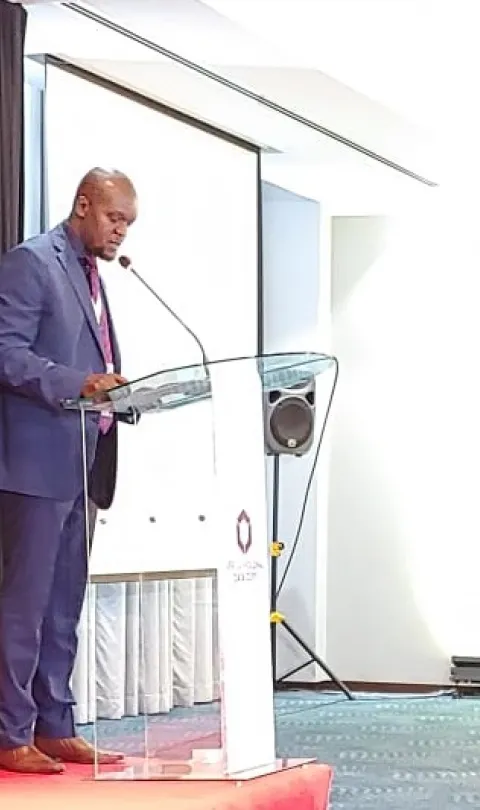21 March 2019. Davis Adieno, Regional Director for Africa, Global Partnership for Sustainable Development Data
H.E. Ambassador Raychelle Omano ‘SC’ Cabinet Secretary for Defence
H.E Hon. Wilbur Otichillo, Govenor, Vihiga County
Dr. Korir Sing’oei, Legal Advisor to H.E the Deputy President
Major General (Rtd) James Aruasa, Chairperson of the Board, Kenya Space Agency
Dr. John Kimani, Ag. Director General, Kenya Space Agency
Representatives of National and County Governments
Representatives of the United Nations in Kenya
Distinguished Guests, Ladies and Gentlemen, all protocols observed.
Habari za asubuhi. Thank you for joining us so early for this event and thanks to any media who also joined us at the pre-breakfast breakfast. Many of us awoke so early that it was still dark and we had a chance to peek up and see the stars. Here in Kenya we are most proud that the Rift Valley is associated with early humans. For thousands of years humans have made sense of the Earth by looking up to the stars. Early farmers used constellations to recognize the changing seasons, and to plant their seeds accordingly.
Today we continue to look from Earth to space and also from space to the Earth. The newly instituted Kenya Space Agency will help us do this and we very much look forward to hearing more on this later.
Global Partnership for Sustainable Development Data
The 193 countries of the UN General Assembly agreed a plan of action for people, planet, and prosperity. To make that plan a reality, governments, civil society organizations and companies need access to reliable and up to date information from many sources, to inform decisions and to track progress. Now time is flying and 2020 is around the corner, we have a decade remaining to achieve the Sustainable Development Goals. We therefore cannot tiptoe forward, we must leap forward and today definitely feels like a leap forward.
The Global Partnership for Sustainable Development Data and its 300+ partners, drawn from all sectors, are the vanguard for forging the path to achieve this, bringing others along with them.
Our three objectives are. First - driving political change to elevate data from the technical to the political when that’s needed. Second, catalyzing new ideas and innovations to meet data challenges. Third, connecting people and organisations to build trust and achieve more effective production, analysis, use of data for sustainable development.
Africa Regional Data Cube
So what is a data cube? Picture a 30 meters squared piece of land – about the size of a small farmhouse. In data cube lingo, this is one pixel. There are 35 million pixels in one scene. Kenya is captured in 34 scenes. Around a decade ago, it would have cost more than $900,000 per year to access imagery and data for Kenya. The data is all free today, but the problems for users didn’t end with opening the data. It was horribly challenging, in terms of resources, capacity, and infrastructure, for each separate user to download, store, process, and analyze the data.
Enter the data cube as the answer. The Africa Regional Data Cube is a data infrastructure that makes 17 years of satellite data easily accessible, usable, and analysis-ready for Kenya as well as our other partner countries: Ghana, Senegal, Sierra Leone, and Tanzania. These countries can use the data cube to improve agricultural production, strengthen food security, optimize urban planning for better disaster prevention and response, and more.
Created by the Committee on Earth Observation Satellites in partnership with GPSDD, Office of the Deputy President in Kenya, the Group on Earth Observations, Strathmore University, and Amazon Web Services. The data cube represents an example of true multi-stakeholder collaboration and responding to country-level demand. After this morning the Kenya Space Agency will lead the efforts, bringing a ‘whole of government’ approach to address critical challenges.
When we first launched the Africa Regional Data Cube a year ago, our country endured severe floods. This month it is drought that is top of mind and the pernicious hunger that results from faltering food production on Kenya’s farms, after two years of unreliable rains.
That’s why, although the potential of Earth observations is almost limitless, from harmful human activity like illegal logging, to tracking pollution of waterways, mapping deforestation and seeing urban sprawl in real-time, today we have decided to focus in on the potential applications for environmental protection and food production, especially when combined with robust data from agricultural surveys and censuses.
The ability to scan almost two decades’ worth of changes in Kenya’s lands will allow a whole new level of agriculture forecasting that can be used to train farmers while also providing a more powerful type of risk assessment that can be critical in securing affordable credit and crop insurance, We’re excited to be working with our colleagues in Kenya to see this rapidly evolving world of data applied to improving the lives of smallholder farmers in Kenya-- and the families across the country who depend on them for a steady supply of affordable, nutritious food.
We look forward to hearing more from Robert Allport of The Food and Agriculture Organization (FAO) about their 50x2030 Initiative, which was launched in September 2018 at a side event of the UN General Assembly sponsored by the Government of Kenya. The impact of this traditional survey data in combination with satellite imagery could be truly transformative. And on the International Day of Forests, we’ll be hearing from colleagues at UN Environment about how remote sensing technology and other data can be used to help protect and restore the vitality of our tropical forests and waterways.
Conclusion
In conclusion, the analysis you’ll hear described today by the many big brains in this room may be complex, but the approach is simple:
The Africa Regional Data Cube provides a combination of access to data, skills training, and capacity building. This straightforward approach is a game-changer for the countries already involved, as they institutionalize this powerful new capability and work out who needs to be brought to the table to make those leaps forward across the spectrum of national priorities and the SDGs. And as we look to the future, the data cube approach has the potential to make even greater impact at scale, as a coalition of partners look to use scale up to more countries in Africa via a project that is in the early planning stages - Digital Earth Africa.
So let me congratulate the Office of the Deputy President on assembling a rich array of experts to inspire and inform us this morning. I wish you all very fruitful deliberations. Thank you.


